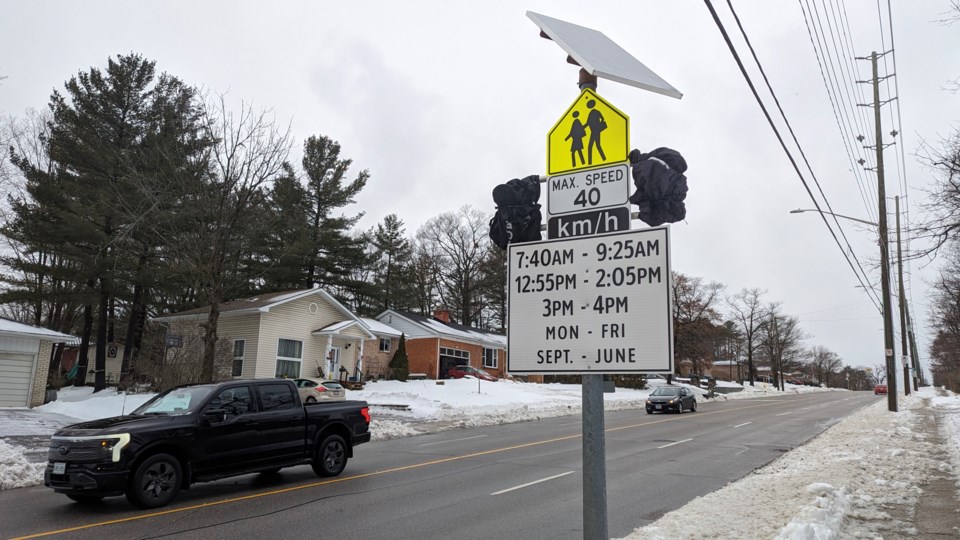Times will be simplified and clarified for drivers navigating Barrie’s new automated speed enforcement (ASE) camera system.
By direct motion Wednesday night, city council changed what’s called the city’s rates of speed bylaw. Enforcement times will move to 7 a.m. until 5 p.m., Monday to Friday, Sept. 1 to June 30 at the speed camera and variable times zones, and basically when students are in school.
Enforcement times are now a complicated 7:40 a.m. to 9:25 a.m., 12:55 to 2:05 p.m., 3 to 4 p.m., Monday to Friday, September until June.
“In a nutshell, what this will do is remove the confusion at the two current ASE locations with the new automated speed cameras has caused,” said Coun. Gary Harvey. “I’ve fielded a few calls, I know the mayor’s office has had some calls, and I would imagine everybody around this (council) table has probably had some calls.
“When you’re travelling at whatever speed you’re travelling at, it’s quite difficult to read these three different times — as the speeds are changing throughout the day," he added.
Harvey said having a solid time, 7 a.m. to 5 p.m. will also cover extracurricular events at schools in the mornings and afternoon.
“And I think it just makes it that much safer for our school zones with having a solid speed of 40 kilometres per hour and also creates less confusion for the drivers,” he said.
Barrie’s first two speed-camera locations are eastbound on Big Bay Point Road near Willow Landing and St. Michael the Archangel Catholic elementary schools, and southbound on Anne Street North, near Portage View and Nouvelle-Alliance schools.
The new times and signs are to be in place by February, when the cameras will be moved to northbound Essa Road near Timothy Christian School and westbound Ardagh Road in the vicinity of Heritage Baptist Church.
While ticket threshold speeds are still under wraps, other than the 40-km/h speed limit, but now new ASE camera operational times will be disclosed.
The ASE system uses a camera and a speed-measuring device to detect and capture images of the licence plates of vehicles travelling faster than the posted speed limit in school or community safety zones. These types of charges are the responsibility of the vehicle owner, and not the driver.
Barrie’s cameras are being rotated through different community safety zones every few months.
The speeding penalty is a fine, and tickets issued through ASE program don’t result in demerit points. The fine is based on by how much the driver is exceeding the speed limit. Fines are doubled in community safety zones, even if the violation occurs outside of school hours.
The city says the speeding tickets will arrive within 30 days after the violation occurs.
Barrie has 27 community safety zones. They are established by municipal councils through a bylaw, and cover road areas where there is a higher risk to, or concern for, drivers, pedestrians, cyclists and/or others who share the space.
Highway Traffic Act fines, including speeding, are doubled in community safety zones and many community safety zones are located close to schools. Barrie has 81 sections of road designated as community safety zones in accordance with the community safety zones bylaw.
But the city says there are different signs in community safety zones with speed cameras. Along with a 'Municipal Speed Camera in Use' sign, there is also one indicating how the speed limit can differ — depending on the time of year, the day and time of day, related to times when children are travelling to and from schools.
The flashing lights to warn of a 40-km/h zone have been replaced because the Ontario government doesn't permit both flashing lights and speed limits that vary to be posted at the same time.
“I think (the direct motion) solves half the problem in terms of creating further clarity and consistency with the times that the speed limit is 40 km/h,” said Coun. Bryn Hamilton. “I don’t agree with the (provincial) legislation — it’s out of our control to change.
“I don’t understand the intent behind covering up flashing lights," she added. "If the intent is actually safety, why wouldn’t you have signs saying flashing lights and a camera?”
Barrie’s ASE camera equipment cost $100,000 and yearly operational costs are $370,000, staff have said. The fines will cover a portion of the ASE program’s costs.
Local Authority Services (LAS), the business services arm of the Association of Municipalities of Ontario (AMO), and the city signed an agreement last summer that LAS will initially fund two provincial offences officers who will process speed-camera violations in Barrie.



